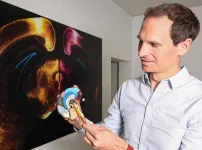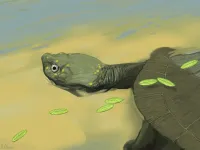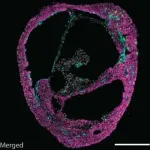Palaeontology: Ancient turtle from Texas yields evolutionary insights
2021-05-20
(Press-News.org) The discovery of the oldest known North American species of side-necked turtle -- turtles that withdraw their necks sideways into their shells when threatened -- is reported in Scientific Reports this week. The findings suggest that side-necked turtles may have migrated to North America during the Cenomanian age (100 to 94 million years ago).
Brent Adrian and colleagues have named the species Pleurochayah appalachius from the Greek word Pleuro (side), the Caddo word Cha'yah (turtle) and the North American Appalachian region. The fossilised remains of P. appalachius, which were discovered at the Arlington Archosaur Site of the Woodbine Group in Texas, USA, date back to the lower middle Cenomanian. They predate remains of Paiutemys tibert, a side-necked turtle species from Utah that dates back to the late Cenomian and was previously recognised as the oldest known side-necked turtle from North America. The authors report a number of features that suggest P. appalachius may have been adapted for life in marine environments. Robust bony protrusions at the end of its humerus, which formed part of its shoulder joint, may have made its stroke more powerful when swimming. The thick outer surface of its shell bones may have strengthened the shell and protected P. appalachius in marine environments.
Analyses of the evolutionary relationships between turtle species suggests that P. appalachius was an early member of the Bothremydidae family of side-necked turtles that originated in the Gondwana supercontinent 145 to 100 million years ago. Based on these findings and the adaptations of P. appalachius to marine environments, the authors suggest that early Bothremydidae may have migrated from Gondwana to North America during or prior to the Cenomanian age via the central Atlantic Ocean or the Caribbean.
INFORMATION:
Article details
An early bothremydid from the Arlington Archosaur Site of Texas
DOI:
10.1038/s41598-021-88905-1
Corresponding Author:
Brent Adrian
Midwestern University, Glendale, Arizona, USA
Email: badria@midwestern.edu
Please link to the article in online versions of your report (the URL will go live after the embargo ends):
https://www.nature.com/articles/s41598-021-88905-1
ELSE PRESS RELEASES FROM THIS DATE:
2021-05-20
How the brain deals with trauma is complex, and it's intuitive to say that we, as humans, get over trauma differently depending on if it happened a long time ago or if it was recent. But what scientific evidence do we have about the way the brain deals with short-term versus long-term traumatic memories?
EPFL scientists have identified the specific regions in the brains of mice responsible for reprograming traumatic experiences towards safety, and the brain regions are indeed different and depend on whether the trauma happened recently or a long time ago. They found that they could facilitate the extinction of long-lasting traumatic memories by enhancing the activity of a primitive region of the brain called the nucleus reuniens. The results are published today in Nature ...
2021-05-20
Montréal, May 20, 2021--Researchers at the University of Montreal Hospital Research Centre (CRCHUM) and Yale University have succeeded in reducing the size of the HIV reservoir in humanized mice by using a "molecular can opener" and a combination of antibodies found in the blood of infected individuals.
In their study published in Cell Host & Microbe, the team of scientists, in collaboration with their colleagues at the University of Pennsylvania and Harvard Medical School, show that they were also able to significantly delay the return of the virus after stopping antiretroviral therapy in this animal model.
Humanized mice are generated from immunodeficient mice that don't have their own ...
2021-05-20
Realizing the potential of self-driving cars hinges on technology that can quickly sense and react to obstacles and other vehicles in real time. Engineers from The University of Texas at Austin and the University of Virginia created a new first-of-its-kind light detecting device that can more accurately amplify weak signals bouncing off of faraway objects than current technology allows, giving autonomous vehicles a fuller picture of what's happening on the road.
The new device is more sensitive than other light detectors in that it also eliminates inconsistency, or noise, associated with the detection process. Such noise can cause systems to miss signals and put autonomous vehicle passengers at risk.
"Autonomous ...
2021-05-20
Scientists from Queen Mary University of London and Rothamsted Research have used radar technology to track male honeybees, called drones, and reveal the secrets of their mating behaviours.
The study suggests that male bees swarm together in specific aerial locations to find and attempt to mate with queens. The researchers found that drones also move between different congregation areas during a single flight.
Drones have one main purpose in life, to mate with queens in mid-air. Beekeepers and some scientists have long believed that drones gather in huge numbers of up to 10,000 in locations known as 'drone congregation areas'. Previous research has used pheromone lures to attract drones, raising concerns ...
2021-05-20
What The Study Did: These preliminary findings using U.S. Centers for Disease Control and Prevention Vaccine Adverse Events Reporting System data in the early phase of societal COVID-19 vaccination using two messenger RNA vaccines suggest that no association exists between inoculation with a SARS-CoV-2 messenger RNA vaccine and incident sudden hearing loss.
Authors: Eric J. Formeister, M.D., M.S., of the Johns Hopkins University School of Medicine in Baltimore, is the corresponding author.
To access the embargoed study: Visit our For The Media website at this link https://media.jamanetwork.com/
(doi:10.1001/jamaoto.2021.0869)
Editor's Note: Please see the article for additional information, ...
2021-05-20
What The Study Did: Researchers assessed associations between prenatal, early postnatal or current exposure to secondhand smoke and symptoms of attention-deficit/hyperactivity disorder (ADHD) among school-age children in China.
Authors: Li-Wen Hu, M.D., Ph.D., and Guang-Hui Dong, M.D., Ph.D., of Sun Yat-sen University in Guangzhou, China, are the corresponding authors.
To access the embargoed study: Visit our For The Media website at this link https://media.jamanetwork.com/
(doi:10.1001/jamanetworkopen.2021.10931)
Editor's Note: The article includes funding/support disclosures. Please see the article for additional information, including other authors, author contributions ...
2021-05-20
BOSTON - Screening for colorectal cancer - the second most common cause of cancer-related death in the United States - can save lives by detecting both pre-cancerous lesions that can be removed during the screening procedure, and colorectal cancer in its early stages, when it is highly curable.
Screening is most commonly performed with endoscopy: visualization of the entire colon and rectum using a long flexible optical tube (colonoscopy), or of the lower part of the colon and rectum with a shorter flexible tube (sigmoidoscopy).
This week, the United States Preventive Services Task Force (USPSTF) lowered the recommended beginning age for screening from 50 to 45 for persons without a family history of colorectal ...
2021-05-20
The discovery of a new species of ancient turtle is shedding light on hard-to-track reptile migrations about 100 million years ago. Pleurochayah appalachius, a bothremydid turtle adapted for coastal life, is described in a new paper published by a multi-institution research group in the journal Scientific Reports.
P. appalachius was discovered at the Arlington Archosaur Site (AAS) of Texas, which preserves the remnants of an ancient Late Cretaceous river delta that once existed in the Dallas-Fort Worth area and is also known for discoveries of fossil crocodyliformes and dinosaurs. P. appalachius belonged to an extinct lineage of pleurodiran (side-necked) ...
2021-05-20
For many engineers and scientists, nature is the world's greatest muse. They seek to better understand natural processes that have evolved over millions of years, mimic them in ways that can benefit society and sometimes even improve on them.
An international, interdisciplinary team of researchers that includes engineers from The University of Austin has found a way to replicate a natural process that moves water between cells, with a goal of improving how we filter out salt and other elements and molecules to create clean water while consuming less energy.
In a new paper published today in Nature Nanotechnology, researchers created a molecule-sized water transport channel that can carry water between cells while excluding protons ...
2021-05-20
Self-organizing heart organoids developed at IMBA - Institute of Molecular Biotechnology of the Austrian Academy of Sciences - are also effective injury- and in vitro congenital disease models. These "cardioids" may revolutionize research into cardiovascular disorders and malformations of the heart. The results are published in the journal Cell.
About 18 million people die each year from cardiovascular diseases, making them the leading cause of fatalities globally. Moreover, the most prevalent birth defects in children pertain to the heart. Currently, a major bottleneck in understanding human heart malformations and developing regenerative therapies are missing human physiological models of the heart.
The research group of Sasha Mendjan established cardioids ...
LAST 30 PRESS RELEASES:
[Press-News.org] Palaeontology: Ancient turtle from Texas yields evolutionary insights




